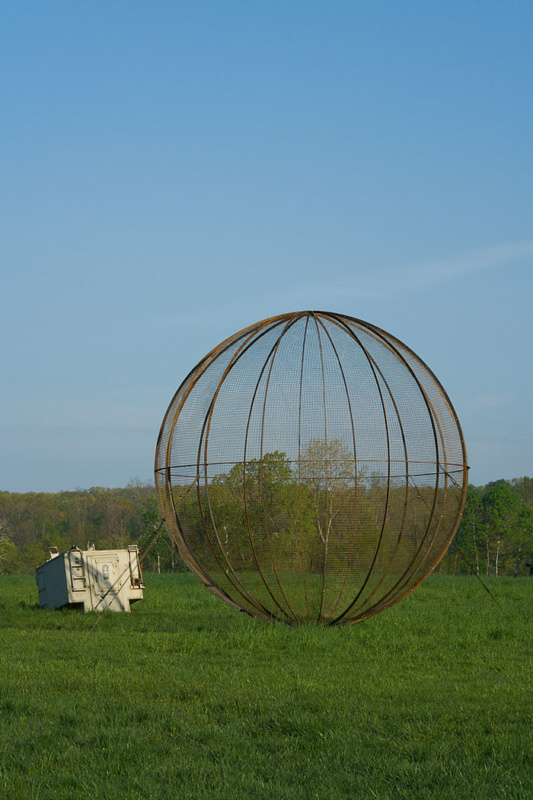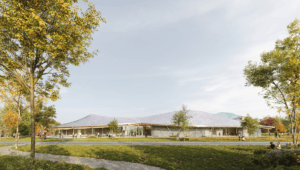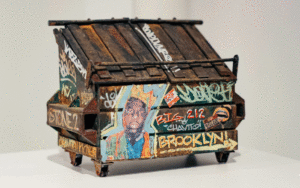Alberta-born, New York–based artist Elaine Cameron-Weir has made a name for herself with her sculptures in all variety of scale, shape, and material. Most recently, she was commissioned by Storm King Art Center as part of their now annual Outlooks series, which invites an emerging or mid-career artist to devise a temporary site-specific installation for the art park. AN sat down with Cameron-Weir to talk about her new sculpture, the problem of design, and, naturally, the apocalypse.
Architect’s Newspaper: Can you remind me of the title of your installation at Storm King; it’s quite a title.
Elaine Cameron-Weir: It’s A toothless grin. A STAR EXPANSION! GLOBE OF DEATH A graveyard orbit. “A toothless grin” is kind of like a play on a colloquial saying, something about missing teeth and death—with connotations of something unsettling, like decay. And then “A STAR EXPANSION!” comes from this fastener company that the people who started Storm King had, the Star Expansion Industries Corporation. I thought that was a beautiful name. The “GLOBE OF DEATH” is what this spherical cage is called that stunt motorcyclists ride around in during shows. And then ‘A graveyard orbit’ is a phrase for the orbit of a satellite that extends beyond its useful orbit; when the satellite is no longer to be used, they send it into a graveyard orbit. It just keeps circling the earth as space junk.
AN: The shelter is a found piece; is the globe also found?
ECW: No, the globe was fabricated specifically for the piece, but it’s based on objects that already exist. So it’s about the same dimensions as the globes of death that are generally the ones that travel to county fairs and other venues.

AN: What was it like working in that sort of scale, at a scale that’s not intended to be experienced in a room but in a landscape?
ECW: The absence of surrounding architecture for art is really strange. I didn’t expect it to be so…it wasn’t difficult, and I wouldn’t say it was easy. It was just there was the removal of the constraints of a room. There’s such a specific way that people behave in an art space. I’ve done projects where it’s been in an environment that’s not specific to looking at art, like abandoned buildings, but you’re still dealing with something that’s around you. And the scale is really different. Something huge does not necessarily look huge outside. And you have to think about the weather and transparency; if the piece itself is partially transparent and if you look at it from a certain angle, it disappears into the trees behind it, whereas in a clean white space, nothing disappears in the same way. It was interesting and I’m really glad I got the chance to do that. Because those things are so obvious after the fact, but until you do something like that, you don’t think about it the same way.
AN: You don’t realize that you were designing objects for a room the whole time.
ECW: Or you do realize it, but then that relationship is removed and you realize that you were operating in a system that’s actually largely invisible to you until you don’t have it, even though you were addressing it.
AN: Part of what you engage with is not just the space in its physicality but also the history of that physical site. Could you give a bit of background of this?
ECW: Con Ed was trying to build a power plant in Storm King Mountain from the early 1960s to 1980, which would’ve totally altered it. There were all these protests and it went to court and eventually, the environmentalists won. It’s not super related to the piece in the end, but I was researching some materials about it: the court documents, reading the transcripts of the people testifying against the project. Basically, they’re just giving these apocalyptic scenarios of what would happen if the power plant were built. It totally reads like science fiction, a hyperbolic vision of the future. I found that really important because I write a lot surrounding my work. It’s kind of like sketching; a way to keep track of ideas. The fact that these documents alluded so much to the future that it became science fiction, that’s kind of what connected this mountain to the project.

AN: There’s an element of fictionalization in the piece, as well, in that you’ve totally detached these objects from their original context. You’re imagining these possible reuses. But it also is a bit apocalyptic. For example, there’s, of course, a repurposed bomb shelter. How do you get things from the military?
ECW: I bought it from some guy in the Midwest on the internet. I didn’t really ask how he got it. But a lot of times people, like resellers, will buy stuff like this at auction in lots. And they’ll resell it to people like me or to people that are making doomsday preparations. Generally, in fictionalized versions of the future, people just get their hands on this kind of equipment somehow because the government’s been destroyed or something and it’s anarchy. There’s a feeling of that kind of future projection in the work for sure.
AN: It’s a bit of a harsh object in some ways. It’s not, like, a pretty thing. I don’t want to harp on the apocalyptic, but are you interested in violence? It is, after all, literally a military object.
ECW: I am a nonviolent person when it comes to confrontation. But I think that most people are interested in violence. And by interested, it doesn’t mean you’re…
AN: Going to go on a killing spree or anything.
ECW: Yeah. It just means you are perhaps terrified by it or you are curious about it, you’ve been a victim of it, you’ve inflicted it. And I don’t think it’s all a bad thing; there are people who are very much devoted to the application of the potential of violence in measured instances. I’m thinking of things like BDSM, or even skydiving. It’s a force of human life, for better or for worse. And I think that what I’m interested in more is the latency of that and the potential. The piece for me is more about potential energy, and I think that there could be a certain amount of violence inherent in potential energy because it’s something that is yet to happen. But I don’t think that my stance with the piece would be that it’s a warning about aggression or that it’s aggressive. I think the violent feeling comes in part from it being human-sized.
AN: Which is actually what I was about to ask you about, the relation to the body and personal scale.
ECW: One way to make something, at least how I’m working right now, is to make it body-sized or relatable in scale, and things that are designed to protect the body also carry a suggestion of violence because they’re preventing harm. If you suggest protection, you suggest violence. And that has to do with the fact that we’re physical animals and we have a body that’s susceptible to all sorts of things.
AN: You just used the word “designed.” You recently spoke on the issue of design and its separation from art proper in Art Forum, saying about the work that “It’s almost like designing. That’s a dirty word, maybe. But my work is related to design.” Of course, you went on to say “Personally, I don’t think design is a dirty word. It really just means making something work.” How do design and architecture intersect with your practice, or diverge from it?
ECW: Some people still don’t love when art and design sit next to each other. It could be seen as disparaging just to say, “Oh, that piece of art looks like design.” I meant it was a dirty word if you look at it from this narrow-minded perspective of thinking that design means shiny plastic objects in a store and maybe an Eames chair. Basically, believing that the need for function kind of upsets the “purity” of our art, which I disagree with. I think that when something has a function or requires a function a lot of interesting things can happen. But it’s not that you need parameters to do something interesting. Earlier we were talking about not having architecture around me to respond to at Storm King. That absence of architecture didn’t make way for some kind of purity, it was just replaced with another set of parameters involved with working outside. With design, things also change. I’m not an architect and I’m not a designer, but I could imagine that making something with a function you would be solving so many different problems all the time. I find that there still could be so much potential for freedom in that.
Outlooks: Elaine Cameron-Weir
Storm King Art Center
1 Museum Road, New Windsor, New York
Through November 25











